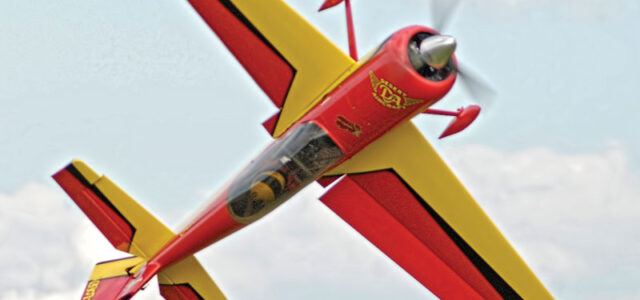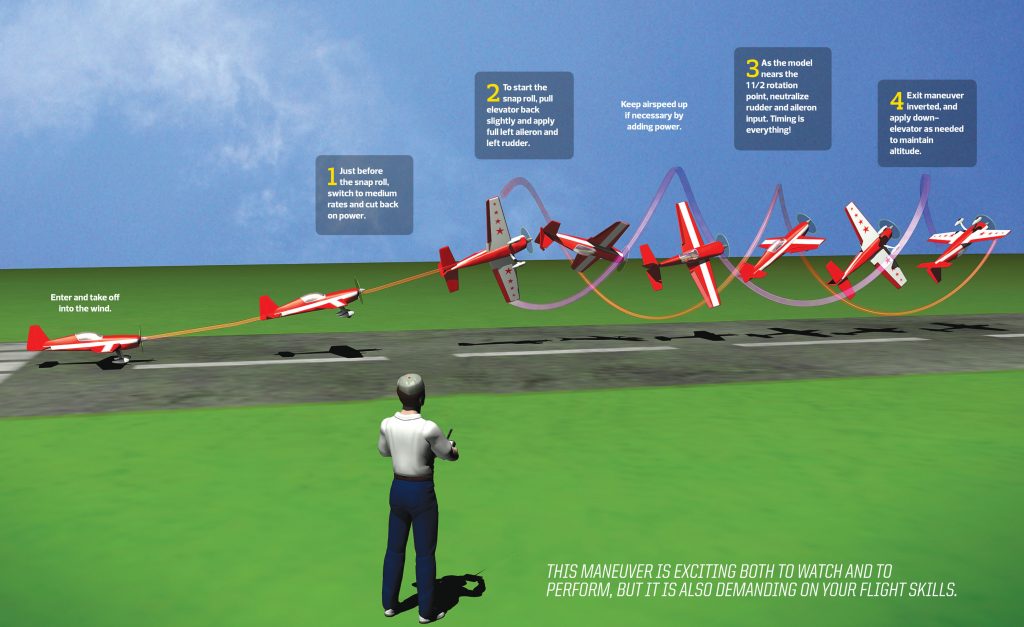If you’re aspiring to become a better aerobatic pilot, you are, no doubt, constantly searching to add excitement and variety to your flying. After all, the best aerobatic pilots are skilled at combining certain elements from one maneuver with elements from another. This month, I am going to combine the snap roll with a takeoff, so you can get attention focused on your flight right from the start. Before we get into a deep discussion about this eye-catching aerobatic move, however, we will take a look at your aircraft and how it is set up regarding dual rates and exponential settings. Now, let’s get down to business.
First Things First
Many aerobatic airplanes today are advertised as being “3D capable,” and they have very large control surfaces so that they can perform maneuvers while in a stalled condition. Having large control surfaces and a lot of control surface deflection, however, are not needed for any maneuver that isn’t considered 3D, and with respect to this month’s maneuver, a lot of control deflection is not a good thing. The goal is to perform a precise 1 1/2 positive snap on takeoff—nice, crisp, and clean.
I prefer to use flight modes, with my dual and/or triple rates on one switch. This means that my aileron, elevator, and rudder rates are on one switch. To perform the combo maneuver of the month, I prefer to use two flight modes. On my lowest rate, I have about 15 degrees of aileron, 12 degrees of elevator, and 35 degrees of rudder deflection, with 20, 25, and 50% exponential, respectively. On my second rate, I have about 30 degrees of aileron, 25 degrees of elevator, and 32 degrees of rudder deflection, with 45% exponential on all these surfaces. Keep in mind that values differ from airplane to airplane.
When I perform any takeoff and landing, I am always on my low-rate settings. When I perform a stunt like a snap roll only feet from the ground, I switch to my mid-rate settings right before the snap roll and switch back to my low-rate setting when the snap roll is completed. While everyone has different personal preferences, this is the setup that has worked best for me as I do not want my aircraft to be sensitive while flying on low rates. No matter what size aircraft you are flying, whether it is a small park flier or a giant-scale one, always take advantage of flight modes and adjust each rate as needed to cater to your liking. For example, once you’re flying, if you move the aileron stick to its maximum and the roll rate of the aircraft is slow, then increase the dual rate percentage for that given rate. Similarly, if you feel that the airplane responds too quickly around neutral but the endpoint value is great (the dual-rate value), then increase the exponential percentage you are using. Do this test for all your control surfaces.
Overview
Before attempting the 1 1/2 positive snap on takeoff, you should be proficient with performing positive snap rolls in general. When you execute this move, you must be in complete control and exit the maneuver at a safe altitude. Do not drop altitude throughout the snap roll as this can be fatal when you’re only feet from the ground!
Depending on the power-to-weight ratio of your aircraft, your throttle percentage may differ slightly. On most of my models, I prefer to apply almost maximum power throughout the takeoff roll and then decrease power slightly once the airplane breaks ground. I then pitch the airplane up slightly by pulling back on the elevator control stick and applying the same-direction rudder and aileron. I’ll release elevator to unload the airplane and ensure that it does not drop any altitude through the rotation. Then, once inverted and after 1 1/2 snaps have been performed, I’ll release aileron and rudder input and apply a touch of down-elevator to sustain level inverted flight. While this may sound simple, there are a lot of different elements that need to be perfected.
By the Numbers
Let’s divide the maneuver into four steps. In this example, we will take off from left to right. Always take off into the wind. If there’s a strong crosswind, take off in a direction that is the most favorable.
STEP 1
While on low rates, add about 80% throttle and apply rudder as needed to keep the airplane straight down the runway. With tail-draggers, you’ll need to hold some up-elevator and slowly release elevator input as the airplane is nearing the liftoff speed. Then, pull back ever so slightly on the elevator stick until the airplane becomes airborne.
STEP 2
Once the airplane is about 15 feet above the ground, flip to your mid-rate setting and cut back slightly on power if the airplane’s speed is too fast. Pull back slightly on elevator, and apply the same-direction aileron and rudder to initiate the snap roll. In this case, we will perform the snap roll to the left, so we will need left aileron and left rudder. Sometimes, people are confused by the control inputs needed in performing snap rolls. When performing a positive snap roll, up-elevator is needed along with aileron and rudder inputs in the same direction. When performing a negative snap roll, down-elevator is required along with opposite directions of rudder and aileron input. It is critical to time this portion of the maneuver so that the airplane will precisely execute exactly 1 1/2 rotations, causing the model exits the maneuver inverted.
STEP 3
Throughout the 1 1/2 rotation, apply throttle (if needed) to keep the airspeed up. Once the airplane nears the 1 1/2 rotation point, you’ll need to neutralize aileron and rudder so that the airplane stops the rotation precisely where desired. This will take practice and some time to perfect, so altitude and familiarity are key. After all, this maneuver should only be done on takeoff if you are confident in your ability to execute snap rolls precisely on demand.
STEP 4
Since the 1 1/2 positive snap rolls have just been performed, you will have to apply down-elevator, as needed, to sustain your altitude. Once you are familiar with how to perform this maneuver, you can then pull the throttle back to lower the airspeed slightly and descend so that you are just inches off the ground while inverted. Of course, this is in a perfect world with no wind present. If a crosswind exists, I recommend that you perform the snap roll into the wind. For example, if we are taking off from left to right and there is a strong wind blowing in, I would snap to the left so that the airplane snaps away from you. Heavy winds may cause the airplane to drift throughout the snap.
Now you have the keys to perform the 1 1/2 positive snap rolls on takeoff with pizzazz. This maneuver is exciting both to watch and to perform, but it is also demanding on your flight skills, so do not attempt it until you are comfortable in executing snap rolls without any loss in altitude. Until next time, safe flying and always remember to have fun.
BY JOHN GLEZELLIS; ILLUSTRATION BY CHROME CITY STUDIOS
























